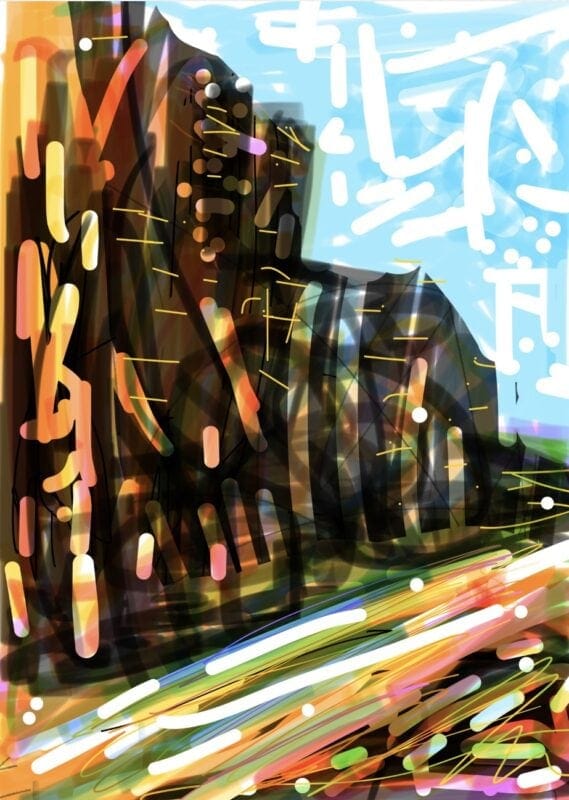
Origin: Minnesota
Currently Exhibiting in: Tucson, Arizona & Bushwick, Brooklyn
Website: deborahsplainartist.com
Instagram: @deborahsplainartist
Facebook: Deborah Splain Artist
Deborah Splain’s work pulses with motion—layered, luminous, and intuitively rendered. From her origins as a muralist to her current explorations in digital media, Splain fuses tactile expression with conceptual velocity. Her compositions are less static image and more kinetic impression—color-driven meditations on the sensory overload of modern life. Whether through mural, sculpture, or fingerprint-layered digital painting, Splain invites viewers to pause inside the blur.
Deborah Splain is a multidisciplinary artist whose career began in the Midwest with large-scale mural work and restoration projects, including commissions at Coffman Memorial Union at the University of Minnesota. She is a graduate of the Women’s Art Institute Studio Intensive at MCAD and an active early member of WARM (Women’s Art Resources of Minnesota).
Drawn westward by her fascination with geological forms and rock imagery, Splain has exhibited work in Scottsdale and Sedona before settling in Tucson. There, she continues to evolve her practice through sculpture and mentorship with renowned sculptor Simon Kogan. Her work weaves together emotional resonance, environmental reflection, and layered materiality—exploring how place, pace, and memory coalesce in form.
Splain frequently donates artwork to charitable causes, including the Make-A-Wish Foundation, Breast Cancer Awareness campaigns, and the Humane Society, demonstrating her belief in art as a conduit for connection and community care.
Featured Artwork at Bushwick Gallery
Speeding
Year of Creation: 2021
Medium: Digital / Layered Fingerprint Painting
Dimensions: 18″ x 24″
Price: $1,200
Description:
A swirling chromatic rush, Speeding captures the velocity of modern urban life through gestural streaks and vibrant digital layering. Created using fingertip painting on a touchscreen, this work translates the sensory overload of the city into an abstract, kinetic form. Pulses of light, blocks of movement, and suggestive architectural silhouettes blur together in a meditation on urgency and overstimulation. Splain’s process involves multiple iterative proofs—printing, revising, and relayering—echoing the relentless evolution of thought and environment. It’s a piece that challenges the viewer to ask: what are we rushing past, and at what cost?

Exhibition Information
April 2025: Urban Narratives: The City as Canvas
Curated by: Fern Messa Joson
Theme: Turning the cityscape into a canvas, this exhibition captures the raw, vibrant energy of urban life through graffiti, street photography, painting, and more.
Guided audio experience
For accessibility, the full video transcript is provided below for those who prefer to read or are unable to listen.
“Pause here—and then try to keep up. Speeding is not a still image. It’s a pulse, a streak, a sprint through the sensory chaos of the modern city. Created entirely through fingertip painting on a touchscreen, Deborah Splain’s work fuses gesture with digital intensity, layering color like velocity itself.
Look at the composition. Light flickers across the surface like a train through tunnels, like headlights on wet pavement. There’s no single focal point. Instead, blocks of motion dissolve into streaks, architectural hints blur at the edges, and the whole piece seems to vibrate with urgency. This isn’t about depicting a place—it’s about evoking a pace.
Splain’s process is recursive and tactile. She prints, revises, relayers—each version absorbing the energy of the last, like a thought that keeps speeding up before it resolves. That iterative quality mirrors city life: the feeling that things are always shifting, and you’re always just slightly behind.
The question embedded here is subtle but sharp: What are we rushing toward? And what might we be missing? In this blur of movement, Splain invites us to locate stillness. Or at least, to wonder if such a thing is possible.
Speeding asks you to feel your own pulse in response—to notice your breath, your pace, your gaze. Because sometimes, the only way to catch a city’s rhythm… is to stop and watch it race by.”